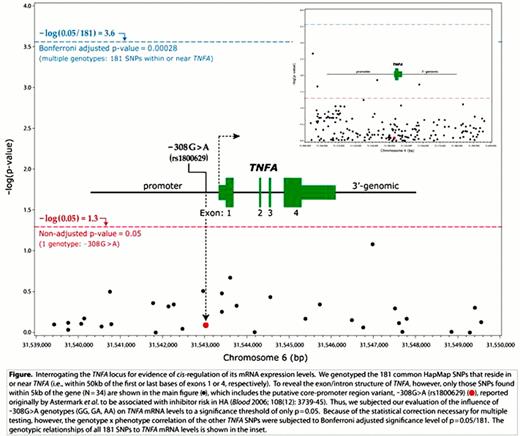Abstract
Abstract 3366
The hemophilia A (HA)-causing Factor (F)VIII gene (F8) mutation type is a well-established determinant of risk for the development of alloimmune inhibitors that neutralize replacement FVIII proteins in ∼20% of all HA patients. Studies have investigated variants of immune response genes to determine if they may account for the inter-individual variability in FVIII immunogenicity observed in patients with the same F8 abnormality, e.g., the intron-22 inversion. While some studies have found associations between inhibitor status and promoter polymorphisms in CTLA4, TNFA and/or IL10, others have not. If these promoter polymorphisms are indeed functional and truly influence inhibitor development, their alleles could modulate transcription initiation rates. The goal of this study was to investigate the possibility of cis-acting genotype-specific differences in mean steady-state mRNA levels encoded by CTLA4, TNFA and IL10.
We examined the relationship of lymphocyte CTLA4, TNFA and IL10 mRNA levels with the genotypes of 265 SNPs located across their structural loci in 1189 Mexican American subjects in the San Antonio Family Heart Study. Expression profiles were generated using Illumina's HWG-6 BeadChips and genotypes came from the Illumina OmniExpress-12 BeadChip. Measured genotype association analyses that accounted for non-independence of family members and employed an additive model (in which testing to determine whether gene expression varies by genotype, with the model constrained so that each “dose” of the minor allele raises or lowers gene expression by an equal amount “beta”) were performed using the software package SOLAR. P-values were calculated using a 1 degree-of-freedom chi-square test comparing the likelihood of a model where the change in expression levels by genotype is estimated to the likelihood of a model where beta is constrained to zero.
None of the 265 genotyped SNPs within or near these three genes (i.e., 49 SNPs in IL10, 35 SNPs in CTLA4 & 181 SNPs in TNFA) function as cis-acting regulatory variants, as no significant genotype-specific associations with these genes' transcript levels were identified.
We observed no evidence for cis-regulation of CTLA4, TNFA or IL10 in Mexican Americans, the largest and most rapidly growing minority population in the United States, despite having genotyped directly the previously implicated promoter polymorphisms in the current analysis (e.g., see Figure ). Although Hispanic American HA patients were recently found to have a significantly higher risk for inhibitor development than White HA patients, it is possible that cis-acting functional variants in this minority population are rare and not well-represented by the common GWAS SNPs used for these analyses. Since linkage disequilibrium patterns between markers are population-specific, we are also currently genotyping these SNPs in a large cohort of African and Caucasian American HA patients.
No relevant conflicts of interest to declare.
Author notes
Asterisk with author names denotes non-ASH members.


This feature is available to Subscribers Only
Sign In or Create an Account Close Modal